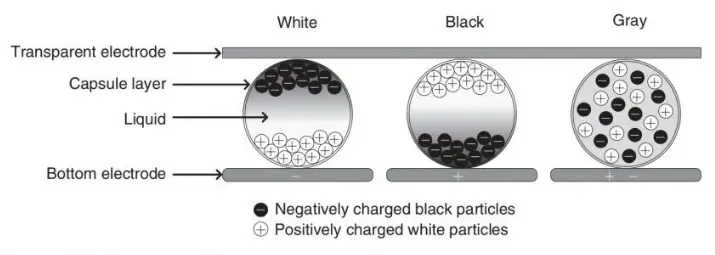At its annual Sharp Tech-Day event being held this weekend in Tokyo, Sharp is showcasing new color versions of its electronic paper display ePosters that use E Ink’s latest Spectra 6 color ePaper technology. These new ePosters are the first products to take advantage of E Ink’s recently released Spectra 6 platform.
The ePosters feature an A2 size display with a 16:9 aspect ratio and resolution of 1728 x 972 pixels. They usee a new IGZO thin-film transistor (TFT) backplane from Sharp that enables more vivid and saturated colors compared to previous ePaper panels. Unlike most digital displays, E Ink’s electrophoretic displays only consumes power when the image changes. This allows ePosters to hold a static image indefinitely without drawing power, enabling battery or solar operation. Sharp will also be showing a smaller 8-inch diagonal Spectra color ePaper prototype with 768 x 1024 resolution aimed at e-reader and notebook applications. However, it is digital signage and posters that really excites me to the possibilities of digital paper.
Digital Signage Comes of Age
Digital signage provides a more dynamic and customizable medium for branding and messaging compared to traditional printed signage and ePaper posters provide one of the best arguments for a digital transformation of displays that have traditionally only been paper. A core advantage of the new technology is the ability to easily update content in real time without reprinting which is a major maintenance cost for non-digital signage. It also allows for responding swiftly to changing promotions, events, or campaigns. Digital signs also enable greater personalization, with the flexibility to customize displays for different locations, audiences, and times of day. Content can be scheduled in advance or rotated continuously.
In contrast, traditional signage requires manually swapping printed signs for any messaging change, which is cumbersome and labor-intensive. The fixed nature of printed signs also restricts the ability to target specific audiences or tailor content.
Another major benefit of digital signage is leveraging data analytics. Digital signs can collect real-time engagement data, tracking customer behavior and measuring campaign effectiveness. This provides valuable consumer insights to better target subsequent content. Traditional signs lack this capability, relying solely on fixed static presentations without useful metrics.
Additionally, digital signage allows for much greater interactivity than traditional signs. Viewers can access information, take surveys, play games and more by directly interacting with the display. Digital signage can incorporate dynamic features like videos, animations, and scrolling text to boost engagement. Traditional printed signs cannot offer this immersive experiential aspect.
From a exposure standpoint, digital signage enables impactful visuals on large, vivid video walls and displays. The dynamic imagery draws more attention than static printed signs. Digital content can also be kept updated perpetually to stay relevant, while traditional signage risks becoming outdated.
The Colorization of Digital Paper
But, digital posters haven’t really come into their own until recently, as the technology for color electrophoretic displays has evolved. The road to color hasn’t been easy. In the 1970s, building on early efforts to create electric displays mimicking paper’s visual properties, researcher Nicholas K. Sheridon at Xerox’s famed Palo Alto Research Center (PARC) conceived of reimagining paper as a reusable display medium. Sheridon’s electric paper embedded bichromal plastic beads in a flexible film, rotating them with electric fields to show black or white. But Xerox shelved Sheridon’s ideas for over a decade.

By the 1990s, with cathode-ray tube monitors falling out of favor and flat-panel displays on the rise, PARC finally revived Sheridon’s concepts as Gyricon. Meanwhile across the country, Joseph Jacobson, a postdoctoral researcher at MIT, hit on a similar notion of using electric fields to manipulate colored pigment particles suspended in microcapsules. Jacobson called his technology electrophoretic ink, or e-ink.
In 1997 Jacobson co-founded E Ink to commercialize his breakthrough, attracting investors and defense funding. E Ink’s early e-paper used the microencapsulated electrophoretic system with black and white pigments Jacobson pioneered. The company quickly moved to integrate a dash of color into prototypes, adding a layer of red or yellow filters over the monochrome ink to create changeable store signs. But this incremental step left technologists hungry for the holy grail of a fully vibrant, multifarious digital paper display.
By the 2000s, E Ink researcher Robert Sprague led efforts to layer conventional liquid crystal display (LCD) style red-green-blue filters over the black-and-white ink layer to create the company’s first, crude color e-paper. Launched in 2010 as Triton, it powered a handful of e-textbooks, but its muted hues and low resolution – a consequence of cramming three filter colors into each pixel – disappointed consumers accustomed to screens with millions of colors.
Meanwhile, PARC veteran Nicholas Sheridon, grandfather of electrophoretic displays, pushed forward with colorization schemes for his “Gyricon” beads at spinoff Gyricon Media. By 2009 Sheridon’s “SmartPaper” achieved a modest palette by twisting dual-colored beads partway between black and white. But despite occasional demos, Gyricon never matched E Ink’s larger investments and rapid advancements.
Back at E Ink, VP Masha Orlitsky and her team scrutinized Triton’s shortcomings and realized printing separate filters was a non-starter. To boost vibrance, the RGB filters would need to be directly patterned onto the e-paper surface. To increase resolution, they had to be miniaturized and dense.
Orlitsky partnered with German company Plastic Logic, an early E Ink investor with expertise printing electronically functional films. Adapting their lab-scale tools to high-volume manufacturing proved a challenge. So too did developing new filter patterns alternating red, green and blue to avoid visual artifacts in image transitions. After evaluating grids and angled lines, E Ink settled on an interlaced, linear RGB design. Carefully engineered light guides directed illumination at the optimal angle to maximize reflectivity.
The result of years of iteration debuted in 2019 as E Ink’s Kaleido. With its bright high-resolution color, Kaleido finally attained the vivid hues consumers demanded. The first Kaleido-based products arrived in 2020, followed soon after by second-generation Kaleido Plus displays with further improved saturation. The two decade quest to bring rich color to digital paper had concluded, with electrophoretic technology at last catching up to imaginations.
Even now, Kaleido’s evolution continues. Engineers labor to heighten light efficiency and resolution through enhancements to film layers and drive electronics. E Ink forges ahead on a next-generation filterless color architecture called Advanced Color ePaper, blending multiple pigments within each pixel. The long road stretches onward, toward ever more vibrant vistas displayed on the digital paper dreamt of long ago.


